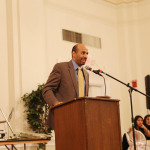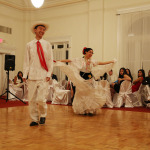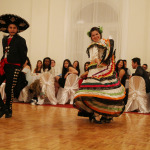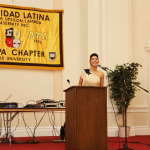Over 200 students gathered on Saturday night to celebrate the Latino community and hear about ways they could aid Hispanic students in the American public education system.
The occasion was the annual Noche Dorada, or “Golden Night” — the largest Latino cultural event on campus all year, organizer William Genova ’15 said. The event, hosted by Kappa Chapter of the La Unidad Latina, Lambda Upsilon Lambda fraternity, had the theme “Communidad: Investing in our Communities through Education.”
The event included performances by the spoken word group “Oye,” Latino dance groups and Bronx-native poet “La Bruja.” These demonstrations were followed by a keynote address by Marco Davis ’92, deputy director of the White House Initiative on Educational Excellence for Hispanics. Davis spoke about the challenges faced by Latinos in the education system and the improvements that have ameliorated their condition in recent years.
“Latino education policy is U.S. education policy,” Davis said. “There has been progress. We are not where we need to be yet, but we seem to be going in the right direction.”
Davis cited data highlighting the struggles and barriers that face young Hispanics in the American educational system. Among these, Davis said, are high school and secondary school completion rates, the disproportionate enrollment of Hispanic students in low-performing schools and the lack of Hispanic students in early education and STEM courses.
The issues facing Latinos in education do not affect the Hispanic community alone, he said, and have wider implications for the success of the American workforce in a global economy.
“Better educated and better trained students lead to a better America,” he said.
When the Initiative on Educational Excellence for Hispanics was created, the population of Latinos in the U.S. numbered 22 million, and one out of every eight students was Latino, Davis said. Now, there are over 54 million Latinos in the U.S., and one out every four students is of Latino heritage.
The U.S. Census Bureau reported that the Hispanic dropout rate has been cut in half, from 28 percent in 2000 to 14 percent in 2011. While there is still a gap between Latino and other groups, the high school graduation rate for Hispanics is at an all time high. The percentage of Hispanics enrolled in STEM courses nationally increased by 33 percent from 1996 to 2004. The number of Hispanic students enrolled in college increased by more than 50 percent from 2008 to 2012, Davis said.
Davis said the improvements are due to efforts by not only the federal government, but also local school districts, higher education institutions, nonprofit organizations, community leaders, Latino families and the students themselves.
He called out to the Latino community in attendance to use their talents and the opportunities for leadership and activism they have at Yale to champion the cause of reforming education for Hispanic youth.
“We all need to be aware of these facts and these challenges in order to take action and make change,” Davis said. “We need leaders like you who understand where our population is, who can make decisions and take action to bring about more equity.”
Natalie Muñoz ’18 said she was inspired by Davis’ call to action and leadership, and added that she is eager to utilize the resources available to her.
David Rico ’16 said he was struck by the abundance of different perspectives that came together at the event.
“I appreciate the diversity of voices. There were White House officials, poets, professors and students,” Rico said.
American Studies professor and Ezra Stiles College Master Stephen Pitti ’91 said this period of change in the United States provides for an important opportunity for Yale students. This is the time to explore avenues for change, he added.
The White House Initiative on Educational Excellence for Hispanics was created through executive order by President George H.W. Bush ’48 25 years ago.











